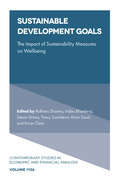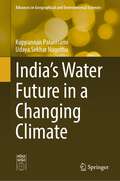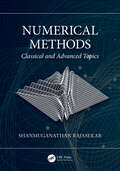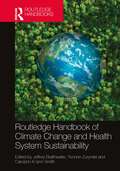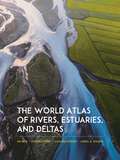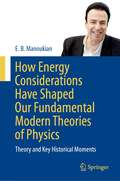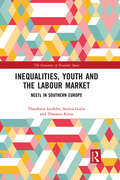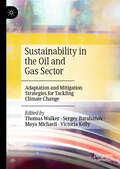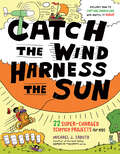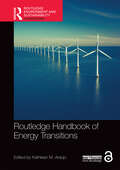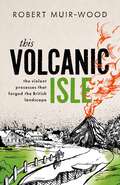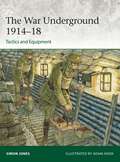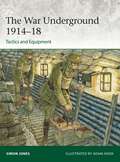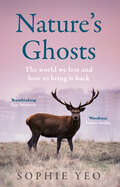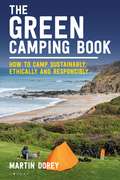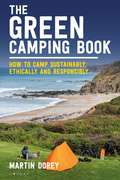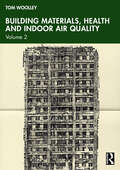- Table View
- List View
Sustainable Development Goals: The Impact of Sustainability Measures on Wellbeing (Contemporary Studies in Economic and Financial Analysis #V113, Part A)
by Ridhima Sharma, Indira Bhardwaj, Simon Grima, Timcy Sachdeva, Kiran Sood, and Ercan ÖzenThe global community is at a critical moment in its pursuit of the Sustainable Development Goals (SDGs); crises are threatening decades of development gains, further delaying the urgent transition to greener, more inclusive economies, and throwing progress on the SDGs even further off track. When it comes to sustainability and combating our current climate emergency, we need sustainable solutions that can protect our water, energy and food resources while also aiming for zero waste. Sustainable Development Goals considers these solutions throughout twelve chapters, introducing the subject of sustainable development then delving into detail of the framework to address these gaps and shortages in different disciplines and sectors. The global drivers of change are analysed and the opportunities and challenges of attainment of development goals are investigated. Contemporary Studies in Economic and Financial Analysis publishes a series of current and relevant themed volumes within the fields of economics and finance. Both disciplinary and interdisciplinary studies are welcome.
Sustainable Development Goals: The Impact of Sustainability Measures on Wellbeing (Contemporary Studies in Economic and Financial Analysis #V113, Part B)
by Ridhima Sharma Indira Bhardwaj Simon Grima Timcy Sachdeva Kiran Sood Ercan ÖzenThe global community is at a critical moment in its pursuit of the Sustainable Development Goals (SDGs); crises are threatening decades of development gains, further delaying the urgent transition to greener, more inclusive economies, and throwing progress on the SDGs even further off track. When it comes to sustainability and combating our current climate emergency, we need sustainable solutions that can protect our water, energy and food resources while also aiming for zero waste. Sustainable Development Goals considers these solutions throughout twelve chapters, introducing the subject of sustainable development then delving into detail of the framework to address these gaps and shortages in different disciplines and sectors. The global drivers of change are analysed and the opportunities and challenges of attainment of development goals are investigated. Contemporary Studies in Economic and Financial Analysis publishes a series of current and relevant themed volumes within the fields of economics and finance. Both disciplinary and interdisciplinary studies are welcome.
India's Water Future in a Changing Climate (Advances in Geographical and Environmental Sciences)
by Kuppannan Palanisami Udaya Sekhar NagothuThis book comprehensively addresses the most challenging water issues in India in a changing climate for the first time and suggests potential solutions. It has been observed that over the past two decades, water usage has significantly increased in India due to population growth, economic development and an increase in multiple uses of water, including irrigation, hydropower, industries, domestic consumption, fisheries, eco-system needs and the environment. India’s water future is mainly influenced by rising food demand to feed the increasing population, emerging climate change impacts on agriculture and the water sector, the increasing cost of interventions, poor cost recovery, the low level of technology adoption and weak water policy.Artificial recharge of the groundwater aquifers, improved water use efficiency and the groundwater–energy–agriculture nexus are important for the future of India’s water planning and are well addressed in this book. Also covered are climate-smart practices, wastewater reuse methods, and digital water and agriculture tools. The book further analyses improved irrigation modernization plans and explores the potential for micro-irrigation expansion including canal and tank irrigation systems in the country.Overall, this book is one of the first of its kind to present India’s future water and irrigation issues with field-based solutions, providing lessons learnt from successful national and international case studies. The volume is a useful resource for a wide range of readers including policy makers, planners, donors, implementing agencies and researchers in the water sector.
Effective Non-Hermiticity and Topology in Markovian Quadratic Bosonic Dynamics (Springer Theses)
by Vincent Paul FlynnThis thesis provides an in-depth investigation of effective non-Hermiticity and topology in many-mode, non-interacting, bosonic systems. It also establishes the extent to which one must move beyond the Hamiltonian, closed-system setting, in order to uncover signatures of genuine symmetry-protected topological (SPT) physics in "free" (mean-field) bosons. While SPT phases of free fermionic matter and their associated zero-energy boundary-localized modes have been thoroughly explored, similar physics in free bosonic systems still remains elusive. No fermionic counterpart exists for the distinctive dynamical behavior that arises from the effective non-Hermiticity, intrinsic even at equilibrium, to bosonic Hamiltonians. Therefore, a much needed paradigm shift is required to address major conceptual roadblocks in the search for SPT bosonic phases.The analysis within develops, in particular, the notion of topological metastability in quadratic bosonic systems subject to Markovian dissipation. The resulting dynamical paradigm was found to be characterized by both a sharp separation between transient and asymptotic dynamics and non-trivial topological invariants. It also features long-lived boundary-localized "Majorana boson" and "Dirac boson" modes, which realize tight bosonic analogues to the edge modes characteristic of fermionic SPT phases. This comprehensive look into non-interacting bosonic systems breaks important new ground for re-imagining quantum phenomena beyond equilibrium, with novel applications in quantum science.
Numerical Methods: Classical and Advanced Topics
by Shanmuganathan RajasekarThis book presents a pedagogical treatment of a wide range of numerical methods to suit the needs of undergraduate and postgraduate students, and teachers and researchers in physics, mathematics, and engineering. For each method, the derivation of the formula/algorithm, error analysis, case studies, applications in science and engineering and the special features are covered. A detailed presentation of solving time-dependent Schrödinger equation and nonlinear wave equations, along with the Monte Carlo techniques (to mention a few) will aid in students’ understanding of several physical phenomena including tunnelling, elastic collision of nonlinear waves, electronic distribution in atoms, and diffusion of neutrons through simulation study.The book covers advanced topics such as symplectic integrators and random number generators for desired distributions and Monte Carlo techniques, which are usually overlooked in other numerical methods textbooks. Interesting updates on classical topics include: curve fitting to a sigmoid and Gaussian functions and product of certain two functions, solving of differential equations in the presence of noise, and solving the time-independent Schrödinger equation.Solutions are presented in the forms of tables and graphs to provide visual aid and encourage a deeper comprehension of the topic. The step-by-step computations presented for most of the problems can be verifiable using a scientific calculator and is therefore appropriate for classroom teaching. The readers of the book will benefit from acquiring an acquittance, knowledge, experience and realization of significance of the numerical methods covered, their applicability to physical and engineering problems and the advantages of applying numerical methods over theoretical methods for specific problems.
Numerical Methods: Classical and Advanced Topics
by Shanmuganathan RajasekarThis book presents a pedagogical treatment of a wide range of numerical methods to suit the needs of undergraduate and postgraduate students, and teachers and researchers in physics, mathematics, and engineering. For each method, the derivation of the formula/algorithm, error analysis, case studies, applications in science and engineering and the special features are covered. A detailed presentation of solving time-dependent Schrödinger equation and nonlinear wave equations, along with the Monte Carlo techniques (to mention a few) will aid in students’ understanding of several physical phenomena including tunnelling, elastic collision of nonlinear waves, electronic distribution in atoms, and diffusion of neutrons through simulation study.The book covers advanced topics such as symplectic integrators and random number generators for desired distributions and Monte Carlo techniques, which are usually overlooked in other numerical methods textbooks. Interesting updates on classical topics include: curve fitting to a sigmoid and Gaussian functions and product of certain two functions, solving of differential equations in the presence of noise, and solving the time-independent Schrödinger equation.Solutions are presented in the forms of tables and graphs to provide visual aid and encourage a deeper comprehension of the topic. The step-by-step computations presented for most of the problems can be verifiable using a scientific calculator and is therefore appropriate for classroom teaching. The readers of the book will benefit from acquiring an acquittance, knowledge, experience and realization of significance of the numerical methods covered, their applicability to physical and engineering problems and the advantages of applying numerical methods over theoretical methods for specific problems.
Routledge Handbook of Climate Change and Health System Sustainability
by Jeffrey Braithwaite Yvonne Zurynski Carolynn K-Lynn SmithThe Routledge Handbook on Climate Change and Health System Sustainability takes the reader on a journey to understand the interconnectedness of human health, climate change, and healthcare systems.The book begins by exploring how climate change is affecting human health through the increasing frequency of natural disasters, such as bush fires, droughts and heatwaves, and the emergence of new infectious diseases, such as the SARS-CoV2 virus, all of which drive up demand for health services that are already heavily burdened by increasing rates of chronic diseases and ageing populations. Chapters then turn to the contribution of the healthcare system itself to climate change— explaining how current clinical practices, including wasteful care of low value, create an unsustainable carbon footprint and threaten the very viability of healthcare systems. Throughout the volume, descriptions of practical solutions and implemented case studies are used to illustrate the feasibility of taking action in the real world of the healthcare delivery ecosystem.Bringing together a mix of forward-thinking environmental and health researchers, policymakers, leaders, managers, clinicians, patients, and health industry leaders to clarify the current state and future of sustainable healthcare systems, this book will be of interest to researchers and policymakers of climate and health systems.
Routledge Handbook of Climate Change and Health System Sustainability
by Jeffrey Braithwaite Yvonne Zurynski Carolynn K-lynn SmithThe Routledge Handbook on Climate Change and Health System Sustainability takes the reader on a journey to understand the interconnectedness of human health, climate change, and healthcare systems.The book begins by exploring how climate change is affecting human health through the increasing frequency of natural disasters, such as bush fires, droughts and heatwaves, and the emergence of new infectious diseases, such as the SARS-CoV2 virus, all of which drive up demand for health services that are already heavily burdened by increasing rates of chronic diseases and ageing populations. Chapters then turn to the contribution of the healthcare system itself to climate change— explaining how current clinical practices, including wasteful care of low value, create an unsustainable carbon footprint and threaten the very viability of healthcare systems. Throughout the volume, descriptions of practical solutions and implemented case studies are used to illustrate the feasibility of taking action in the real world of the healthcare delivery ecosystem.Bringing together a mix of forward-thinking environmental and health researchers, policymakers, leaders, managers, clinicians, patients, and health industry leaders to clarify the current state and future of sustainable healthcare systems, this book will be of interest to researchers and policymakers of climate and health systems.
The World Atlas of Rivers, Estuaries, and Deltas
by Jim Best Stephen Darby Luciana Esteves Carol WilsonA stunningly illustrated atlas of the world&’s rivers, estuaries, and deltas, and their ecosystemsFrom the Congo and the Mekong to the Seine and the Mississippi, Earth&’s rivers carve through landscapes before coursing into the world&’s oceans through estuaries and deltas. Their inexorable flow carries sediment and more, acting as lifeblood for a variety of ecosystems and communities. More than any other surface feature of Earth, rivers, estuaries, and deltas are vitally important to our economic and social well-being, and our management of them often sits at the sharp edge of today&’s most pressing environmental challenges. The World Atlas of Rivers, Estuaries, and Deltas takes readers on an unforgettable tour of these dynamic bodies of water, explaining how they function at each stage of their flow. Combining maps and graphics with informative essays and beautiful photos, this invaluable reference book will give you a new appreciation for the power that rivers, estuaries, and deltas wield.Features a wealth of color photos, maps, and infographicsBrings together invaluable perspectives from leading expertsDescribes the rich biodiversity associated with the world&’s rivers, estuaries, and deltasExplains how rivers, estuaries, and deltas work, from river networks to deltaic floodplains, and sheds light on the erosion, movement, and deposition of sedimentDescribes the anatomy of rivers, estuaries, and deltas, from channel geometry and river planforms to estuarine shape and delta morphologyExamines the ecology and ecosystems of rivers, estuaries, and deltas and how humans interact with these environmentsAdditional topics include damming, climate change, water use, pollution, resource management, and planetary health, as well as future perspectives on these vital landscapes
How Energy Considerations Have Shaped Our Fundamental Modern Theories of Physics: Theory and Key Historical Moments
by E. B. ManoukianAt long last, with sufficient technical details, emphasizing key historical moments, a book that develops all of fundamental modern theoretical physics from energy considerations in a compact form. Starting with a few electron-volts of atoms in the quantum world at low energies extending up to quantum gravity and beyond to the birth of the Universe, readers will experience the entire spectrum of fundamental modern theoretical physics, with one theory leading to another in an integrated unified manner. Energy considerations lead to the development of special and general relativity, quantum field theory, renormalization theory, modern quantum electrodynamics, electro-weak theory, the standard model of particle physics, grand unified theories, string theory, the current standard model of inflationary big bang theory, and even to the birth of the Higgs field, and in developments of quantum gravity. Unfortunately, due to strong specialization within theirfields, students and many practicing physicists are exposed only to parts of the beautiful story of modern fundamental physics. Here the entire story is told! This is a must-read book for graduate students, advanced undergraduate students, instructors and professionals who are interested in all aspects of fundamental modern theoretical physics and key historical moments in its development.
Inequalities, Youth and the Labour Market: NEETS in Southern Europe (The Dynamics of Economic Space)
by Theodoros Iosifides Stelios Gialis Thanasis KizosThis book thoroughly examines the socio-economic and labor market paths of young NEETs, particularly migrants and women, in the disadvantaged regions of Mediterranean Southern Europe—specifically, the island, coastal, and peripheral areas of Greece, Cyprus, Italy, and Spain.It embraces a holistic approach, delving into multiple dimensions of the phenomenon. Rooted in multi-methodological research, it seamlessly integrates quantitative and qualitative methods to provide a comprehensive understanding. Geographically, it spans four Southern European countries, meticulously exploring vulnerable social groups like migrant and women NEETs, which have been understudied. Furthermore, the book illuminates the influence of space and spatial patterns on the NEET phenomenon, effectively connecting precariousness and social exclusion with geography and spatial inequalities across different scales.The book appeals to a diverse audience, spanning human geography, sociology, and migration studies. It extends its relevance to social scientists exploring poverty, social exclusion, precariousness, and socio-spatial injustices. Additionally, it offers valuable insights for postgraduate students in these fields and serves as a complementary resource in social science methodology and theory courses at both graduate and postgraduate levels.
Inequalities, Youth and the Labour Market: NEETS in Southern Europe (The Dynamics of Economic Space)
by Theodoros Iosifides Stelios Gialis Thanasis KizosThis book thoroughly examines the socio-economic and labor market paths of young NEETs, particularly migrants and women, in the disadvantaged regions of Mediterranean Southern Europe—specifically, the island, coastal, and peripheral areas of Greece, Cyprus, Italy, and Spain.It embraces a holistic approach, delving into multiple dimensions of the phenomenon. Rooted in multi-methodological research, it seamlessly integrates quantitative and qualitative methods to provide a comprehensive understanding. Geographically, it spans four Southern European countries, meticulously exploring vulnerable social groups like migrant and women NEETs, which have been understudied. Furthermore, the book illuminates the influence of space and spatial patterns on the NEET phenomenon, effectively connecting precariousness and social exclusion with geography and spatial inequalities across different scales.The book appeals to a diverse audience, spanning human geography, sociology, and migration studies. It extends its relevance to social scientists exploring poverty, social exclusion, precariousness, and socio-spatial injustices. Additionally, it offers valuable insights for postgraduate students in these fields and serves as a complementary resource in social science methodology and theory courses at both graduate and postgraduate levels.
Sufficiency in Business: The Transformative Potential of Business for Sustainability (Neue Ökonomie #2)
by Maike Gossen Laura NiessenBusinesses want to be sustainable but how can they promote sufficiency? Sufficiency-oriented business models focus on creating sustainable value, promoting reduced resource consumption and adjusting production volumes to planetary boundaries. The contributors to this volume present real-life examples of sufficiency-oriented companies across diverse industries. These experts share their insights on sufficiency strategies in business, barriers and opportunities discovered, and the impact on customer behavioural change. They address the far-reaching changes in business, society, and policy required for this paradigm shift and suggest future research directions.
Sustainability in the Oil and Gas Sector: Adaptation and Mitigation Strategies for Tackling Climate Change
by Thomas Walker Sergey Barabanov Maya Michaeli Victoria KellyThe push for sustainability in the oil and gas sector has taken center stage in both climate action debates and mitigation/adaptation efforts in recent decades. As the global mission for sustainable energy increasingly moves away from oil and gas as primary resources, the study of sustainability in the industry is often posited as counterintuitive. However, it is imperative to unearth methods to integrate sustainability efforts in the oil and gas industry, as it will likely retain its prominence in the foreseeable future. This book ignites academic discussion regarding ongoing and necessary mitigation and adaptation strategies in the oil and gas industry that will help address the ongoing climate crisis.The chapters featured in this collection pose several important queries regarding current sustainability efforts in the oil and gas industry and propose avenues for improvement. In particular, they focus on carbon emissions in exploration and production, land use patterns andbiodiversity, and ethics in the oil and gas industry. Working against the background of the UN Agenda 2030 and Sustainable Development Goals, this book will be of great interest to academics and students of sustainability strategies, energy, innovation, and business ethics, as well as policymakers and practitioners tasked with analyzing these areas.
Catch the Wind, Harness the Sun: 22 Super-Charged Projects for Kids
by Michael J. CadutoGet charged up about energy! With more than 20 fun activities and experiments that will have children ages 8 to 12 enthusiastically engaged with making and using renewable energy, Michael J. Caduto takes a hands-on approach to fighting climate change. Step-by-step instructions for projects range from using the sun to make fires to charging electronic devices by peddling your bicycle. Additional energy case studies encourage kids to think about the basic tenets of resource management. Change the world — one miniature windmill at a time.
Routledge Handbook of Energy Transitions (Routledge Environment and Sustainability Handbooks)
by Kathleen M. AraújoThe Routledge Handbook of Energy Transitions draws upon a unique and multidisciplinary network of experts from around the world to explore the expanding field of energy transitions.This Handbook recognizes that considerable changes are underway or are being developed for the modes in which energy is sourced, delivered, and utilized. Employing a sociotechnical approach that accounts for economics and engineering, as well as more cross-cutting factors, including innovation, policy and planning, and management, the volume considers contemporary ideas and practices that characterize the field. The book explores pressing issues, including choices about infrastructure, the role of food systems and materials, sustainability, and energy democracy. Disruption is a core theme throughout, with the authors examining topics such as digitalization, extreme weather, and COVID-19, along with regional similarities and differences. Overall, the Routledge Handbook of Energy Transitions advances the field of energy transitions by connecting ideas, taking stock of empirical insights, and challenging how we think about the theory and practice of energy systems change.This innovative volume functions as an authoritative roadmap with both regional and global relevance. It will be an essential resource for students, policymakers, researchers, and practitioners researching and working in the fields of energy transitions, planning, environmental management and policy, sustainable business, engineering, science and technology studies, political science, geography, design anthropology, and environmental justice.“With the exception of Chapter 26, no part of this book may be reprinted or reproduced or utilised in any form or by any electronic, mechanical, or other means, now known or hereafter invented, including photocopying and recording, or in any information storage or retrieval system, without permission in writing from the publishers.” Chapter 26 of this book is freely available as a downloadable Open Access PDF at http://www.taylorfrancis.com under a Creative Commons [Attribution-Non Commercial-No Derivatives (CC-BY-NC-ND)] 4.0 license.
This Volcanic Isle: The Violent Processes that forged the British Landscape
by Robert Muir-WoodFrom the natural geometry of the Giant's Causeway to the sarsen slabs used to build Stonehenge, we are surrounded by evidence for the extraordinary geological forces that shaped the British Isles. Running coast to coast through Devon is 'Sticklepath', Britain's 'San Andreas', a geological fault with the two sides displaced horizontally by several kilometres, all within the recent geological past. The Sticklepath Fault is just one manifestation of the rich tectonic history of the British region since the asteroid collision that ended the reign of the dinosaurs, 66 million years ago. Raised out of the Chalk Sea, the original Albion was a thickly forested island a thousand kilometres long, surrounded by chalk cliffs, punctuated with great volcanoes, and the site of two trial 'spreading ridge' plate-boundaries. As the volcanoes shifted west, and Greenland separated from Europe, the wind-blown volcanic ash laid the strata on which London was founded. The vertical Needles, known to every Isle of Wight sailor, are part of the northern foothills of the Pyrenees. When the collision subsided, rifting created a garland of Celtic lakes from Brittany to the Outer Hebrides. In This Volcanic Isle Robert Muir-Wood explores the rich geological history of the British Isles, and its resulting legacy. Along the way he introduces the personalities who shared a fascination for Britain's tectonic history, including Charles Darwin the geologist, Tennyson the science-poet, and Benoit Mandelbrot, the pure mathematician who labelled the west coast of Britain a fractal icon. Here is the previously untold story of how earthquakes and eruptions, plumes and plate boundaries, built the British Isles.
This Volcanic Isle: The Violent Processes that forged the British Landscape
by Robert Muir-WoodFrom the natural geometry of the Giant's Causeway to the sarsen slabs used to build Stonehenge, we are surrounded by evidence for the extraordinary geological forces that shaped the British Isles. Running coast to coast through Devon is 'Sticklepath', Britain's 'San Andreas', a geological fault with the two sides displaced horizontally by several kilometres, all within the recent geological past. The Sticklepath Fault is just one manifestation of the rich tectonic history of the British region since the asteroid collision that ended the reign of the dinosaurs, 66 million years ago. Raised out of the Chalk Sea, the original Albion was a thickly forested island a thousand kilometres long, surrounded by chalk cliffs, punctuated with great volcanoes, and the site of two trial 'spreading ridge' plate-boundaries. As the volcanoes shifted west, and Greenland separated from Europe, the wind-blown volcanic ash laid the strata on which London was founded. The vertical Needles, known to every Isle of Wight sailor, are part of the northern foothills of the Pyrenees. When the collision subsided, rifting created a garland of Celtic lakes from Brittany to the Outer Hebrides. In This Volcanic Isle Robert Muir-Wood explores the rich geological history of the British Isles, and its resulting legacy. Along the way he introduces the personalities who shared a fascination for Britain's tectonic history, including Charles Darwin the geologist, Tennyson the science-poet, and Benoit Mandelbrot, the pure mathematician who labelled the west coast of Britain a fractal icon. Here is the previously untold story of how earthquakes and eruptions, plumes and plate boundaries, built the British Isles.
The War Underground 1914–18: Tactics and Equipment (Elite #256)
by Simon JonesThis absorbing illustrated study reveals the evolving tactics and techniques used by all sides in the underground war during 1914–18. Covering the Western Front but also the Gallipoli and Italian theatres, this study explores three aspects of World War I below ground: military mining, attack tunnels and dugouts. In 1914–17, the underground war was a product of static trench warfare, essential to survive it and part of both sides' attempts to overcome it. In 1917–18 it was rendered largely obsolete by the development of the all-arms battle as mobility was restored to the battlefield. In the stagnant, troglodyte existence of trench warfare, military mining was a hidden world of heroism and terror in which hours of suspenseful listening were spent monitoring the steady picking of unseen opponents, edging quietly towards the enemy, and judging when to fire a charge. Break-ins to enemy mine galleries resulted in hand-to-hand fighting in the darkness. The ingenuity, claustrophobia and tactical importance of the underground war are discussed and depicted in this fully illustrated study from an acknowledged expert. The artwork plates include depictions of the specialized uniforms, weapons and equipment used underground, as well as vignettes that vividly convey the many aspects of subterranean warfare during World War I.
The War Underground 1914–18: Tactics and Equipment (Elite #256)
by Simon JonesThis absorbing illustrated study reveals the evolving tactics and techniques used by all sides in the underground war during 1914–18. Covering the Western Front but also the Gallipoli and Italian theatres, this study explores three aspects of World War I below ground: military mining, attack tunnels and dugouts. In 1914–17, the underground war was a product of static trench warfare, essential to survive it and part of both sides' attempts to overcome it. In 1917–18 it was rendered largely obsolete by the development of the all-arms battle as mobility was restored to the battlefield. In the stagnant, troglodyte existence of trench warfare, military mining was a hidden world of heroism and terror in which hours of suspenseful listening were spent monitoring the steady picking of unseen opponents, edging quietly towards the enemy, and judging when to fire a charge. Break-ins to enemy mine galleries resulted in hand-to-hand fighting in the darkness. The ingenuity, claustrophobia and tactical importance of the underground war are discussed and depicted in this fully illustrated study from an acknowledged expert. The artwork plates include depictions of the specialized uniforms, weapons and equipment used underground, as well as vignettes that vividly convey the many aspects of subterranean warfare during World War I.
Nature’s Ghosts: The world we lost and how to bring it back
by null Sophie YeoWhat history can teach us about how to avoid ecological catastrophe ‘Sophie writes fantastically, chronicling the most important issues facing nature conservationists today.’ Chris Packham For thousands of years, humans have been the architects of the natural world. Our activities have permanently altered the environment – for good and for bad. In Nature’s Ghosts, award-winning journalist Sophie Yeo examines how the planet would have looked before humans scrubbed away its diversity: from landscapes carved out by megafauna to the primeval forests that emerged following the last Ice Age, and from the eagle-haunted skies of the Dark Ages to the flower-decked farms of more recent centuries. Uncovering the stories of the people who have helped to shape the landscape, she seeks out their footprints even where it seems there are none to be found. And she explores the timeworn knowledge that can help to fix our broken relationship with the earth. Along the way, Sophie encounters the environmental detectives – archaeological, cultural and ecological – reconstructing, in stunning detail, the landscapes we have lost. Today, the natural world is more vulnerable than ever; the footprints of humanity heavier than they have ever been. But, as this urgent book argues, from the ghosts of the past, we may learn how to build a more wild and ancient future.
The Green Camping Book: How to camp sustainably, ethically and responsibly
by Mr Martin DoreyFrom Martin Dorey - lifelong camper, campervanner and committed environmentalist - a manifesto on how to camp greener and more responsibly while enjoying the outdoors.Planet earth is in crisis. Climate change is affecting everyone, and everyone has a responsibility to do all they can to make things better, including campers and campervanners. In fact, it often falls to us to protect our spaces and fight to keep them the way we like them.This book shows us how we can do it. The Green Camping Book signposts you towards making more sustainable choices about kit, where to stay, how to travel, what to wear, and what we can keep doing to fight for green spaces we love. It is a book for people who want to reduce their impact and carbon footprint but don't want to stop exploring. It is for people who want to get out, off the sofa, and into the wilderness without doing it further damage. It is for people who think they could do more, but don't know how. It asks of everyone who likes spending time outdoors to think about their impact and to take urgent, important steps to soften their footprint on the world.
The Green Camping Book: How to camp sustainably, ethically and responsibly
by Mr Martin DoreyFrom Martin Dorey - lifelong camper, campervanner and committed environmentalist - a manifesto on how to camp greener and more responsibly while enjoying the outdoors.Planet earth is in crisis. Climate change is affecting everyone, and everyone has a responsibility to do all they can to make things better, including campers and campervanners. In fact, it often falls to us to protect our spaces and fight to keep them the way we like them.This book shows us how we can do it. The Green Camping Book signposts you towards making more sustainable choices about kit, where to stay, how to travel, what to wear, and what we can keep doing to fight for green spaces we love. It is a book for people who want to reduce their impact and carbon footprint but don't want to stop exploring. It is for people who want to get out, off the sofa, and into the wilderness without doing it further damage. It is for people who think they could do more, but don't know how. It asks of everyone who likes spending time outdoors to think about their impact and to take urgent, important steps to soften their footprint on the world.
Building Materials, Health and Indoor Air Quality: Volume 2
by Tom WoolleyIn Building Materials, Health and Indoor Air Quality: Volume 2 Tom Woolley uses new research to continue to advocate for limiting the use of hazardous materials in construction and raise awareness of the links between pollutants found in building materials, poor indoor air quality and health problems. Chapters in this volume reinforce previous arguments and present new ones covering: Further evidence of the health impacts of hazardous emissions from materials Hazardous materials to be avoided and why Fire and smoke toxicity – the Lakanal House and Grenfell Tower legacy Sub-standard retrofits leading to damp and mould in previously sound houses A critical review of recent reports from UK Government and others on air quality and health problems including policy changes on flame retardants Growing evidence of cancer risks and the failure of cancer research organisations to address these issues A critical review of recent climate change and zero carbon policies and a discussion on whether extreme energy efficiency is a good thing This book asks some important and, for some, uncomfortable questions, but in doing so it brings to light important areas for research and provides much needed guidance for architects, engineers, construction professionals, students and researchers on hazardous materials and how to reduce their use and design and build healthier buildings for all occupants.
Building Materials, Health and Indoor Air Quality: Volume 2
by Tom WoolleyIn Building Materials, Health and Indoor Air Quality: Volume 2 Tom Woolley uses new research to continue to advocate for limiting the use of hazardous materials in construction and raise awareness of the links between pollutants found in building materials, poor indoor air quality and health problems. Chapters in this volume reinforce previous arguments and present new ones covering: Further evidence of the health impacts of hazardous emissions from materials Hazardous materials to be avoided and why Fire and smoke toxicity – the Lakanal House and Grenfell Tower legacy Sub-standard retrofits leading to damp and mould in previously sound houses A critical review of recent reports from UK Government and others on air quality and health problems including policy changes on flame retardants Growing evidence of cancer risks and the failure of cancer research organisations to address these issues A critical review of recent climate change and zero carbon policies and a discussion on whether extreme energy efficiency is a good thing This book asks some important and, for some, uncomfortable questions, but in doing so it brings to light important areas for research and provides much needed guidance for architects, engineers, construction professionals, students and researchers on hazardous materials and how to reduce their use and design and build healthier buildings for all occupants.
